Ifaty, now merged with Mangily, is the country's second primary upscale beach resort. I would have easily become the first, if the road conditions were just a little better than a sand track.
|
 |
 |
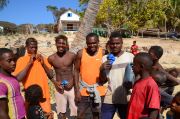 |
 |
 |
 |
 |
 |
Fishermen of Ifaty-Mangily
 |
 |
When I visited Madagascar back in 2001, I just passed by Ifaty. I did have plans to visit it, but I was stuck in Toliara for a couple of days extra than planned. Not because of the almost impassable sandy track between Ifaty and Toliara, but due to a messed up car rental.
The Ifaty-Mangily is a bit hard to navigate. The beach is not adjacent to the main south-north route. So, if one wants to browse the beach-side accommodation options, the best way to do that is by the beach. Not ideal if one has to lug their bags along. Mangily is better from this point of view, as the beach is more continuous. Although it depends on tides. Otherwise, one would need to do a lot of hiking back and forward from and to the beach from the main route.
Mangily was perhaps the highlight of my 'back to Madagascar' trip in 2013. After being nervous to go back to the country since it has been my favourite destination out of all 160 countries I had visited up until September 2013, in Mangily I realised it did not need to be. The short visit to this fishing village simply confirmed that Madagascar is simply the best holiday destination for any serious traveller, leisure traveller, explorer, botanist, zoologist, photographer... The people, most of whom did not speak any western language but only Malagasy, were absolutely huggable. They were the friendliest people on Earth and they wore perfect smiles!
The best places to stay in Ifaty-Mangily was along the beach. The best places to mingle with the locals were at the beach and along the main route, where locals bars and discos were based. The baobabs and the most dramatic landscape were about half an hour hike inland. And the number of the giant trees was ... uncountable!
|
|
| Favourite spots: |
 |
 |
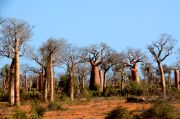 |
 |
 |
 |
 |
 |
Baobab trees near Mangily
 |
 |
When in Ifaty-Mangily, one has a selection of endless sandy beaches, big baobab trees, and a number of village squares to choose for a favourite spot. And the choice would not be very easy. Everything around looked perfect, felt perfect and was complemented by perfectly friendly people.
I was torn between the a white table directly on the beach at sunset with a cold bottle of beer, the little spot on the beach where local fishermen mended their nets, and a local bar on the main thoroughfare which was the centre of nightlife.
While at the table, I could contemplate being on a perfect holiday and have time for my own, chatting with the fishermen and watching them at work was the ultimate Malagasy experience. But getting my hair down (whatever is left of it) and socialise with the villagers and observing them how they relaxed after work was priceless.
|
|
| What's really great: |
 |
 |
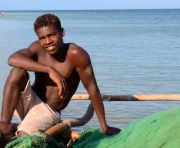 |
 |
 |
 |
 |
 |
A fisherman from Ifaty-Mangily
 |
 |
Well, part of me liked the fact that Ifaty was so remote, but the other part would have preferred to meet more locals. Still, the number of locals at Ifaty-Mangily was sufficient to occupy all of my time. As I said, the village confirmed that Madagascar was the perfect travel destination.
As I was walking along the beach, I came across a bunch of local fishermen aged from 15 to 45, who were preparing their nets and the vessel. As I approached them, as my big fat camera was swaying from my shoulder, all of them automatically smiled. And these were not artificial smiles. They were genuine and friendly. Is there a better way of showing a visitor that they are perfectly welcome? Most of them did not even speak French, so communication was a challenge. Yet, it was never a barrier. The guys were natural, genuine and pure. They never stopped working and never stopped smiling. They did not feel intimidated by me being present there and snapping a few shots. Later, I gave them a few t-shirts.
|
|
| Sights: |
 |
 |
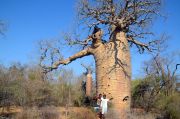 |
 |
 |
 |
 |
 |
The 1700 years old baobab tree
 |
 |
The 1700 year old large baobab tree was Ifaty-Mangily's main attraction. It was not easy to find for someone, who has never been to the village. It took about half an hour of hiking to reach it from the coast. Locals were happy to lead the way for a price of MGA10,000 (£2.50). Some would insist that it was better to take a zebu cart, but in my opinion the hike on foot was much better. It was not easy to wade in the sand track, but being on foot meant one could stop just anywhere, walk towards the giant trees, chat with locals on the way, and simply take one's time.
The other sight around Ifaty-Mangily were the cetaceans. In season. A few deep sea fishing companies, run mainly by the French, offered whale watching. One could also ask the fishermen for the favour as well. And taking a small pirogue out into a deep ocean offered thrills on a different level. Watching the guys navigate using no electronic tools but take directions from the position of the sun was unforgettable. Impressive!
|
|
| Accommodations: |
 |
 |
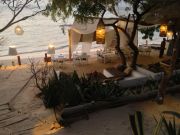 |
 |
 |
 |
 |
 |
Princesse du Lagon beachfront garden
 |
 |
Using booking.com I reserved a room at the rather upscale Princesse du Lagon in Mangily proper for MGA100,000 (€34), which did not feel too excessive at all. Actually, for one got at this boutique hotel and spa was a very good value. The directress of the hotel herself picked me up from the airport (MGA120,000 extra fee). She had a remarkable attention to detail and made the hotel looked superb. There was plenty of local art around and everything was kept in white. Not an easy endeavour in Africa! The rooms were decorated very tastefully, comfortable beds had mosquito nets, and the bathroom had a spa ambiance. Toiletries were lush.
The directress made sure the actual spa, complete with the infinity pool right on beach offered sunset views. The bonfire, surrounded with comfy sofas, was on in the evenings and the lanterns around the garden and the beachfront restaurant added to the ambiance. There was no wifi, but the directress permitted using her machine for internet access and email.
|
|
| Nightlife: |
 |
 |
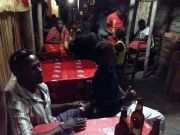 |
 |
 |
 |
 |
 |
At a local bar in Mangily
 |
 |
Sebastian Discotheque was the main nightlife spot in the village. It did not always get busy, but almost adjacent to it was a local bar that always did. I went to Sebastian's once. It had a good bar and plenty of space to boogie and a bunch of tables to sit down and chat to potential dance partners. But it did not get going until wee hours of the morning, so I decided not stay much longer. Instead, I was partying at a local bar, that blasted Malagasy music through massive loudspeakers. It had little room to manoeuvre, nevermind dancing, but it never stopped local guys from showing off their moves in the tiny space between the tables. As the guys consumed more beer and local fiery water (some kind of rhum served in tiny bottles), their moves became more flamboyant. It was a great fun.
For a small village like Mangily, the number of local bars was impressive. I do not think I managed count them all but there were at least ten. Yet, some did not always get their drinks supply, incl. soda!
|
|
| Hangouts: |
 |
 |
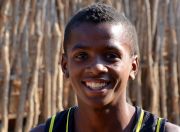 |
 |
 |
 |
 |
 |
The village champion of petanque
 |
 |
A few bars along the main road in Mangily were also perfect spots to re-hydrate during the day and meet the locals, as well as witness some petanque being played to a world class degree. The main petanque 'stadium' was at the corner of the main road and the alley leading to Princesse du Lagon, by one of the largest bars in the village, which never seemed to have any drinks. In fact, the supervisor engaged in the petanque rather than serving at the bar. The spot was perfect for just hanging out and watching how good the lads were at this sport. It was incredible, really. One of the smaller slim guys, just 16 years old, who was the village champion, had a perfect smile. This, again, is why I love Madagascar so much. People smile so nicely. As soon as I approached the guys, he welcomed my presence with his friendliest smile. It is an incredible feeling to be instantly accepted like that. I watched the guys play everyday.
|
|
| Restaurants: |
 |
 |
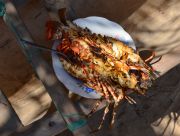 |
 |
 |
 |
 |
 |
Two grilled lobsters for the price of 35,000 ariary
 |
 |
I did not eat at any of the many Ifaty-Mangily restaurants. But it meant that I could have uber-fresh lobsters grilled beautifully directly on the beach, courtesy of the local fishermen. They would approach the visitors asking them if they wanted to go for an option like that. I would recommend this very highly. The lobsters were straight from the ocean and one could ask the guys to grill them according to one's liking. Right on the beach! And one could watch. The meal was served on the pirogues parked in the sand.
As this was business, it was a good idea to negotiate the price. The fishermen's first asking price was MGA30,000 (£8.60) for one lobster. It was a bit cheeky as one could get an entire lobster meal for MGA25,000 at a hotel restaurant. So, I negotiated it down and eventually ended up ordering two lobsters for the price of MGA35,000, which came with rice that I gave away and scoffed the lobsters only. I repeated this feast three times over! The fishermen were happy. So was I!
|
|
| Other recommendations: |
 |
 |
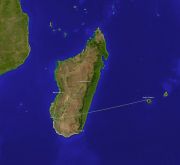 |
 |
 |
 |
 |
 |
Direct flight connections to major airports from Toliara as of September 2013
 |
 |
Ifaty was services by the airport of Toliara, which was only about 25km away. However the impossible (erm... impassable) state of the road between Toliara and Ifaty meant that no taxi driver would be happy to make the trip for any less than MGA200,000 (€68). It took over an hour by a four-wheel drive car to make this short distance. The Toliara airport (TLE) had regular direct connections with Reunion, Antananarivo, Tolagnaro, Morondava and occasionally with Morombe.
There was a somewhat regular but infrequent bus (a converted truck with plenty of clearance) connecting Toliara and Ifaty, which continued farther north to Morombe.
|
|
Published on Saturday November 9th, 2013
|
|
 Publish on Facebook
Publish on Facebook
|
| Information: |
| Login if you are a member, or sign up for a free membership to rate this report and to earn globo points! |
|
| France |
|
|
 |
| French Guiana |
|
|
 |
| French Polynesia |
|
|
 |
| Gabon |
|
|
 |
| Gambia, the |
|
|
 |
| Georgia |
|
|
 |
| Germany |
|
|
 |
| Ghana |
|
|
|
|
|
|
 |
| Gibraltar |
|
|
 |
| Greece |
|
|
|
|
|
|
|
|
|

|
